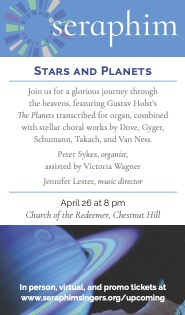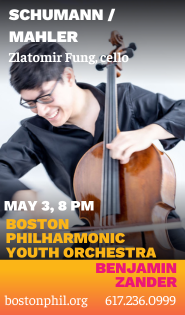Chameleon Arts Ensemble closes season with Debussy, Schoenberg and Stravinsky

The Chameleon Arts Ensemble performed Saturday night at First Church.
Continuing its exploration of the works and influences of Schoenberg, the Chameleon Arts Ensemble capped of its 15th anniversary season Saturday evening at First Church.
The program was titled “mystic moons and dream music,” and as you would guess, included Schoenberg’s game-changing song cycle, Pierrot Lunaire. The Chameleons also offered a chamber orchestra arrangement of Debussy’s Prélude à l’après-midi d’un faune, and the four-hand piano version of Stravinsky’s Rite of Spring.
Fifteen years of programs proves two things: that the Chameleons are good at what they do—examining the stylish fringes of contemporary music—but also that there is an appreciative audience for artistic director Deborah Boldin’s ideas and the group’s skills.
Neither the arrangement of L’après-midi, nor the four-hand rendering of Rite of Spring, would likely exist on their own merits without the well-known orchestral versions.
Schoenberg had Debussy’s classic reset for the available chamber players in a series of private concerts that he hosted; here, ten players, with single instruments representing the orchestral sections, tackled the lush, impressionistic score. Given the instrumentation, the musical focus fell to the winds, and the work—instead of a swirling, atmospheric feast—got stripped down to its melodic core. Prominent lines from flutist Boldin and oboist Nancy Dimock provided the most interest, while Elizabeth Schumann’s piano part also figured prominently.
Gloria Chien joined Schumann for the rhythmic romp of Stravinsky’s own four-hand arrangement of Rite of Spring. Schumann occupied the treble side of the bench, and pedaled. This was playing of the highest kind, a great combination of confidence and terror. This score works best as a study in the elegantly complex rhythms, and in articulating the unique chords Stravinsky presents in the original. There is far too reductive note-spinning to make this arrangement a complete musical success, but certainly that was not the fault of this compelling performance. Not every phrase got articulated precisely, but that’s to be expected from a work that intends chaos, which sacrifices clarity for impetuous pulses and exotic harmonies.
Capping off this anniversary season with Pierrot Lunaire seemed perfectly apt. Soprano Janna Baty fronted a septet of Chameleon’s core players, making the Sprechstimme vocals more musical than theatrical.
Apart from its unique spoken/sung text, Pierrot stands out for its individual instrumental parts. The frame might be atonal, but the resulting structure has inherent musicality and many poignant instrumental moments. Three short notes from the clarinet (Gary Gorczyca) touchingly signal a transition in part one. A flute solo (Boldin) brings an aching conclusion to that opening section, a depiction of Pierrot’s hopeless compulsions toward lust and strangeness.
A grand quartet—flute, clarinet, violin (Gabriela Diaz) and cello (Rafael Popper-Keizer)—heralds the end to the bizarre, morbid second part (Die Kreuze). And the nightmarish Serenade in part three, with its text focused on a viola player (and the viola in the ensemble silent), was brought to dark life by the cello. All were played with distinction.
Word painting was Baty’s strength. Her diction slipped on occasion, but her ability to color certain sections, notably Eine blasse Wäscherin and Der kranke Mond (in part one) and especially Der Mondfleck (near the conclusion) gave Pierrot’s inscrutable story a musical framework.
The program repeats 4 p.m. Sunday afternoon at First Church. chameleonarts.org
Posted in Performances




